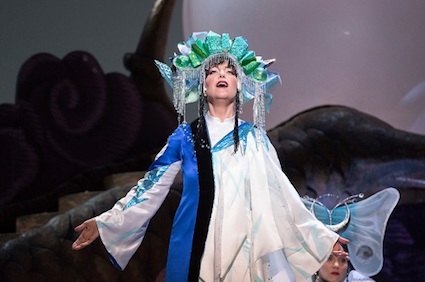
02 Mar 2018
Turandot in San Diego—Prima la voce
The big musical set pieces in Turandot require voice, voice, and more voice, and San Diego Opera has gifted us with a world-class cast of singing actors.
English Touring Opera are delighted to announce a season of lyric monodramas to tour nationally from October to December. The season features music for solo singer and piano by Argento, Britten, Tippett and Shostakovich with a bold and inventive approach to making opera during social distancing.
This tenth of ten Live from London concerts was in fact a recorded live performance from California. It was no less enjoyable for that, and it was also uplifting to learn that this wasn’t in fact the ‘last’ LfL event that we will be able to enjoy, courtesy of VOCES8 and their fellow vocal ensembles (more below …).
Ever since Wigmore Hall announced their superb series of autumn concerts, all streamed live and available free of charge, I’d been looking forward to this song recital by Ian Bostridge and Imogen Cooper.
Although Stile Antico’s programme article for their Live from London recital introduced their selection from the many treasures of the English Renaissance in the context of the theological debates and upheavals of the Tudor and Elizabethan years, their performance was more evocative of private chamber music than of public liturgy.
Evidently, face masks don’t stifle appreciative “Bravo!”s. And, reducing audience numbers doesn’t lower the volume of such acclamations. For, the audience at Wigmore Hall gave soprano Elizabeth Llewellyn and pianist Simon Lepper a greatly deserved warm reception and hearty response following this lunchtime recital of late-Romantic song.
For this week’s Live from London vocal recital we moved from the home of VOCES8, St Anne and St Agnes in the City of London, to Kings Place, where The Sixteen - who have been associate artists at the venue for some time - presented a programme of music and words bound together by the theme of ‘reflection’.
'Such is your divine Disposation that both you excellently understand, and royally entertaine the Exercise of Musicke.’
‘And there was war in heaven: Michael and his angels fought against the dragon; and the dragon fought and his angels, And prevailed not; neither was their place found any more in heaven … that old serpent … Satan, which deceiveth the whole world: he was cast out into the earth, and his angels were cast out with him.’
There was never any doubt that the fifth of the twelve Met Stars Live in Concert broadcasts was going to be a palpably intense and vivid event, as well as a musically stunning and theatrically enervating experience.
‘Love’ was the theme for this Live from London performance by Apollo5. Given the complexity and diversity of that human emotion, and Apollo5’s reputation for versatility and diverse repertoire, ranging from Renaissance choral music to jazz, from contemporary classical works to popular song, it was no surprise that their programme spanned 500 years and several musical styles.
The Academy of St Martin in the Fields have titled their autumn series of eight concerts - which are taking place at 5pm and 7.30pm on two Saturdays each month at their home venue in Trafalgar Square, and being filmed for streaming the following Thursday - ‘re:connect’.
The London Symphony Orchestra opened their Autumn 2020 season with a homage to Oliver Knussen, who died at the age of 66 in July 2018. The programme traced a national musical lineage through the twentieth century, from Britten to Knussen, on to Mark-Anthony Turnage, and entwining the LSO and Rattle too.
With the Live from London digital vocal festival entering the second half of the series, the festival’s host, VOCES8, returned to their home at St Annes and St Agnes in the City of London to present a sequence of ‘Choral Dances’ - vocal music inspired by dance, embracing diverse genres from the Renaissance madrigal to swing jazz.
Just a few unison string wriggles from the opening of Mozart’s overture to Le nozze di Figaro are enough to make any opera-lover perch on the edge of their seat, in excited anticipation of the drama in music to come, so there could be no other curtain-raiser for this Gala Concert at the Royal Opera House, the latest instalment from ‘their House’ to ‘our houses’.
"Before the ending of the day, creator of all things, we pray that, with your accustomed mercy, you may watch over us."
The doors at The Metropolitan Opera will not open to live audiences until 2021 at the earliest, and the likelihood of normal operatic life resuming in cities around the world looks but a distant dream at present. But, while we may not be invited from our homes into the opera house for some time yet, with its free daily screenings of past productions and its pay-per-view Met Stars Live in Concert series, the Met continues to bring opera into our homes.
Music-making at this year’s Grange Festival Opera may have fallen silent in June and July, but the country house and extensive grounds of The Grange provided an ideal setting for a weekend of twelve specially conceived ‘promenade’ performances encompassing music and dance.
There’s a “slide of harmony” and “all the bones leave your body at that moment and you collapse to the floor, it’s so extraordinary.”
“Music for a while, shall all your cares beguile.”
The hum of bees rising from myriad scented blooms; gentle strains of birdsong; the cheerful chatter of picnickers beside a still lake; decorous thwacks of leather on willow; song and music floating through the warm evening air.

The big musical set pieces in Turandot require voice, voice, and more voice, and San Diego Opera has gifted us with a world-class cast of singing actors.
Lise Lindstrom has been performing her signature title role in all of the world’s leading houses and it is easy to see why she is in demand. Ms. Lindstrom has all the stamina, range, and vocal quality required to succeed in this fiendishly difficult “sing.” Her searing upper range is steady and full without ever becoming acidic. Her low and middle ranges have a round, warm appeal that help humanize the icy princess to a certain degree.
Lise is also a lovely presence on the stage, dramatically committed and exuding an unerring musicality. That the voice still sounds fresh and free after so many outings with this punishing part (and others) attests to her rock solid technique. That she still communicates spontaneity and truthfulness in her portrayal attests to her intelligent artistry. I’m not Guinness, but I am guessing that the diva is setting a world record with her career totals of singing this part.
She was well matched by the solid tenor Carl Tanner. The role of Calaf in general and the aria Nessun dorma in particular are weighted with the baggage of expectations. Corelli, Carreras, Del Monaco, Domingo and most especially Pavarotti scored legendary successes in the role. Luciano’s famed rendition of the aria was nearly inescapable in its popularity. Mr. Tanner (who has performed the part over 100 times) makes the part his own sporting a sturdy, engaging instrument that is even throughout the range.
While his voice has considerable weight, he can soar above the staff with skill and an easy power. He embodies all the pathos required inNon piangero Liu, and checks all the blocks with an assured Nessun dorma. If he doesn’t have quite the final Italianate ping and sheen we are accustomed to, his knowing portrayal is nonetheless immensely affecting.
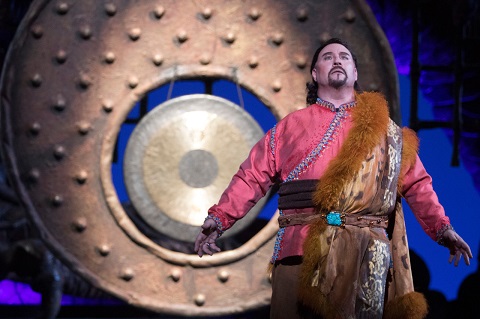 Tenor Carl Tanner (Calaf). Photo credit: J. Katarzyna Woronowicz Johnson.
Tenor Carl Tanner (Calaf). Photo credit: J. Katarzyna Woronowicz Johnson.
As can happen, Liu threatens to run away with the show. Part of the reason is that she is the only sympathetic character in this oft troublesome piece of writing. But she still has to deliver the goods and in a role debut, the buoyantly appealing Angel Joy Blue does all that and more. Ms. Blue has an uncommonly alluring spinto soprano, limpid and secure, and she knows just how to caress a phrase and touch the soul. Her two famous arias are served up with heartfelt investment in every utterance, and her floated high notes were particularly ravishing.
Brian Kontes offered a notably well sung Timur. Mr. Kontes has a rolling, charismatic bass with dusky overtones and wonderfully weighted presence. He found every inch of measured pathos in a part that sometimes gets short shrift. His assured stage presence made a substantial contribution to the evening’s success.
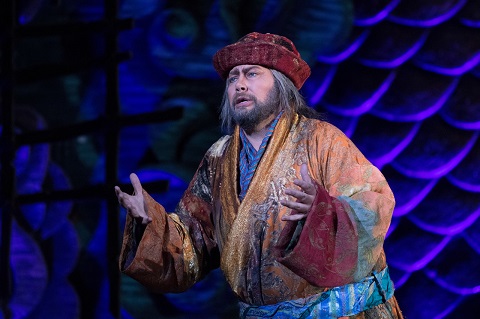 Bass Brian Kontes (Timur). Photo credit: J. Katarzyna Woronowicz Johnson.
Bass Brian Kontes (Timur). Photo credit: J. Katarzyna Woronowicz Johnson.
Ping, Pang and Pong were enthusiastically embodied by respectively, Marco Nistico; Joseph Gaines, and Joel Sorenson. Mr. Nistico’s Ping was warm-voiced and stylistically secure, although his substantial baritone sometimes seemed a bit covered in the upper middle. Mr. Gaines, as Pang, showed off his well-schooled, poised tenor all the while investing the part with his usual animation and dramatic commitment. Pong was well taken by Mr. Sorenson, who has a lean, shining tenor that admirably rounded out the trio.
While the three meshed beautifully as a team, at times functioning like a manic Commedia troupe, they found fully-realized, personalized characterizations. Their introspective yearnings for home in the Act II opening scene, were spell-binding in their melancholy and vocal beauty. Rounding out the cast, Chad Frisque’s plaintive, steady tenor made a good impression as the Emperor, and Scott Sikon’s stentorian bass-baritone made the most of the Mandarin’s declamations. Bruce Stasyna’s well-tutored chorus proved a powerful presence and their nuanced vocalizing was another potent element in the night’s musical arsenal.
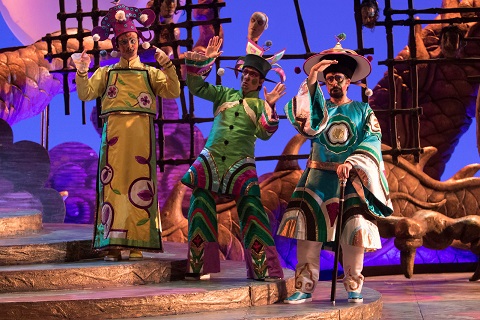 Tenor Joseph Gaines (Pang), tenor Joel Sorensen (Pong) and baritone Marco Nistico (Ping). Photo credit: J. Katarzyna Woronowicz Johnson.
Tenor Joseph Gaines (Pang), tenor Joel Sorensen (Pong) and baritone Marco Nistico (Ping). Photo credit: J. Katarzyna Woronowicz Johnson.
In the pit, conductor Valerio Galli whipped up a rousing reading , delighting in the detailed, angular chinoiserie, and eliciting a fine sense of ensemble that fully supported the singers without ever once overwhelming them. Maestro Galli’s winning grasp of the verismo style was evident throughout, and he ably coaxed and encouraged the talented orchestra to cover itself in glory.
The physical production was all one could wish. Allen Charles Klein has used a huge, snaking Chinese dragon as the basis for his set design and it was a strikingly effective solution. Mr. Klein borrowed a page from Wieland Wagner and has a large raked disc center stage, from which steps of circles spill downstage and to the sides, creating other playing spaces. With the addition of steps up to a higher stage right platform (for Altoum), and steps to an upturned “claw” that reaches right, giving us a wonderful playing space that offers plenty of levels. At one point a giant crystal ball is being held by said “claw.” A gong unit cleverly descends from the flies on cue.
Although this is the basis for the design, it never feels like a unit set. In Act One, grids of oversized, criss-crossed pick up sticks frame the action. Act Two begins with a black scrim isolating part of the downstage “discs” which become the library for the ministers of state, with the simple addition of chests/desks that contain their scholarly scrolls. For Act III, a mid-stage foliage-like arch hovers over the stage, obscuring the basic structure until the re-entrance of the full cast for the climax.
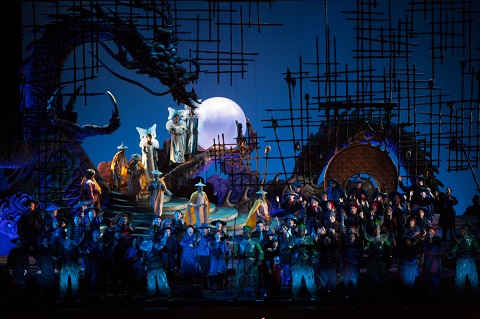 Scene from San Diego Opera’s Turandot. Photo credit: J. Katarzyna Woronowicz Johnson.
Scene from San Diego Opera’s Turandot. Photo credit: J. Katarzyna Woronowicz Johnson.
All of this was made to look atmospheric and sumptuous thank to the vibrant, well-judged lighting design from Lucas Krech. Mr. Krech calibrated a full palette of color washes, created good area definition, and utilized effective isolated specials to marvelous effect. The transition from the ominous bluish night of fear and threats, to the dawn of love and absolution was particularly striking. Willa Kim’s colorful, lavish costumes were a visual delight. Ms. Kim manages to dazzle the eye even while dressing the commoners in rich earth tones befitting their station. Steven W. Bryant’s skillful wig and make-up design completed the total success of the physical production.
Keturah Stickann has staged the epic with care and imagination. There are long stretches of massed ensemble singing, and Ms. Stickann manages to move the traffic to ever more interesting groupings and stage pictures. She makes excellent use of the levels to suggest the shifting power between the principles.
Although Puccini and his librettists have not given a wealth of detailed background to the characters (Calaf is especially undefined if tuneful), this director has worked with her cast to provide as much specificity as possible, while creating believable character relationships. Keturah has found a wealth of humor in the lively antics of the ministers, and created a truly moving moment after Liu’s suicide. I won’t completely give it away but it evokes a sort of touching “walk to paradise garden.”
This commendable production does exactly what any fine rendition must do: maximize the substantial musical excellences and successfully distract from the vagueness of characters’ individual emotional journeys. As the rafters rattled with some pretty thrilling singing, you knew you were at the right address.
It is hard to believe that a company capable of such a top tier assemblage of internationally acclaimed talent almost slipped from the opera scene two years ago. I hope that that problem is firmly behind SDO, since there is decidedly no problem with high quality of the product.
James Sohre
Puccini: Turandot
Mandarin: Scott Sikon; Liu: Angel Joy Blue; Calaf: Carl Tanner; Timur: Brian Kontes; Ping: Marco Nistico; Pang: Joseph Gaines; Pong: Joel Sorenson; Emperor Altoum: Chad Frisque; Princess Turandot: Lise Lindstrom; Prince of Persia: Felipe Prado; Handmaidens: Sarabeth Belon, Caroline Nelms; Conductor: Valerio Galli; Director: Keturah Stickann; Set Design: Allen Charles Klein; Costume Design: Willa Kim; Lighting Design: Lucas Krech; Wig and Make-up Design: Steven W. Bryant; Chorus Master: Bruce Stasyna.